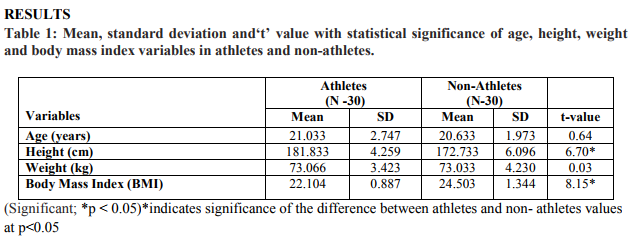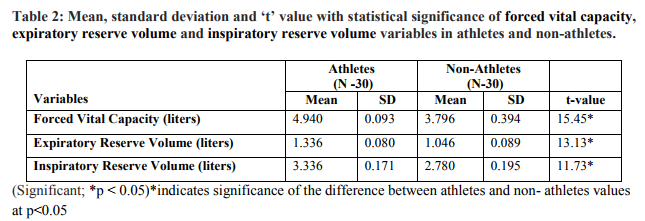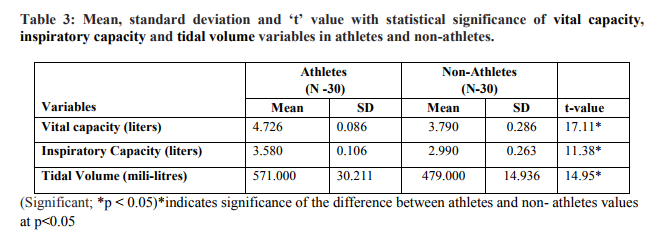IJCRR - 4(13), July, 2012
Pages: 79-84
Date of Publication: 18-Jul-2012
Print Article
Download XML Download PDF
A COMPARATIVE STUDY OF LUNG FUNCTIONS TEST BETWEEN ATHLETES AND NON-ATHLETES
Author: Karanjit Singh, Vishaw Gaurav, Mandeep Singh
Category: General Sciences
Abstract:The purpose of the study was to compare the lung volumes and capacities between athletes and non athletes. Sixty college going young male subjects (athletes: N=30 and non-athletes: N=30) of 18-25 years were randomly selected from different colleges affiliated to Guru Nanak Dev University, Amritsar, Punjab, India. All the participants were assessed for height, weight and body mass index. Lung functions
test was performed with a computerized spirometer following the procedures and predicted values recommended by the American Thoracic Society. Lung functions parameters i.e. forced vital capacity, expiratory reserve volume, inspiratory reserve volume, vital capacity, inspiratory capacity and tidal volume were measured.The independent samples t-test used for data analysis. The level of p 0.05 was considered significant. Statistical analysis showed significant differences between athletes and nonathletes of all the lungs function variables. It was observed that all lung function parameters of athletes were higher than non-athletes (p< 0.05). It was concluded that athletes have greater lungs functions in comparison with non-athletes. Results of the present study therefore suggest that sporting activity, sports training and exercise may cause an increase in the lungs function which could be due to increased development of respiratory musculature incidental to physical training. This study provides evidence that sporting activity has an influence on the lungs function test.
Keywords: Lungs Function Test, Athlete, Non-athlete, Spirometer.
Full Text:
INTRODUCTION
Respiratory system is an important system of a human body where gaseous exchange takes place with diffusion of enormous amounts of oxygen into the blood during physical activity (Khurana, 2005). The lung function tests, like other physiological tests must be of the utmost importance for measuring the fitness of an individual from a physiological point of view (Astrand and Rodahl, 1970). Lungs function parameters tend to have a relationship with lifestyle such as regular exercise and non- exercise (Wasserman et al., 1995; Twisk et al., 1998).The apparently simple function of the lung is to deliver O2 to gas exchanges surface and exhaust CO2 to atmosphere. Lungs functions test is a powerful tool to measure volumes and capacities of an athlete in physiology lab. In addition to measuring volumes and capacities, it provides information regarding response to training or exercise and monitors the response following respiratory problems including exercise induced bronco spasm (McGraw-Hill‘s 2001). Due to regular exercise, athletes tend to have an increase in respiratory capacity when compared to nonexercising individuals. Exercise is stressful condition which produces a marked change in body functions and lungs are no exception. Sedentary life styles could be associated with less efficient pulmonary functions. There are several studies that have shown significant improvement in pulmonary functions as a result of the effect of exercise (Chandran et al., 2000; Shivesh et al., 2007).However, there are studies which show nonsignificant change in pulmonary functions as an effect of exercise (Hamilton and Andrew 1976; Kuppu and Vijayan 1988). In athletes lung volumes and capacities alters during resting state and intense exercise. Lung function tests provide qualitative and quantitative evaluation of pulmonary function and are therefore of definitive value in the diagnosis and therapy of patients with cardio -pulmonary disorders as well as those with obstructive and restrictive lung disease (Belman and Mittman, 1980; Robinson and Kjeldgaard, 1982). The parameters used to describe lung function are the lung volumes and lung capacities. The pulmonary functional capacities of normal sedentary individuals have been studied extensively in India (Singh, 1959; Rao et al., 1961; Singh, 1967; Jain and Ramiah, 1969; Gupta et al., 1979). Therefore, the purpose of the study was to compare the lung function parameters between athletes and non athletes.
MATERIAL AND METHODS
The present study was conducted on Sixty college going young male subjects (athletes: N=30 and non-athletes: N= 30) of 18-25 years age. The subjects were selected as athletes who have been participated in inter-university championships and subjects selected as non-athletes who have been not participated any sporting activity. All subjects randomly selected from the different colleges affiliated to Guru Nanak Dev University, Amritsar, Punjab, India. The age of each subject was calculated from the date of birth as recorded in his institute. The height of the subjects was measured with anthropometric rod to the nearest 0.5 cm. The weight of subjects was measured by using portable weighing machine to the nearest 0.5 kg. Body mass index was calculated as body weight adjusted for stature. Lung functions testing were performed with a computerized spirometer following the procedures and predicted values recommended by the American Thoracic Society. All Spirometric measurements were performed under standard conditions of body temperature and ambient pressure and with water vapor saturation with the subjects sitting down and wearing a nose clip. The forced vital capacity, expiratory reserve volume, inspiratory reserve volume, vital capacity inspiratory capacity and tidal volume were measured in each subject and recorded in absolute values. Each subject performed 3 acceptable maneuvers according to the American Thoracic Society recommendations.
Statistical analysis:
The lung functions test were compared in both the athletes and non-athletes groups by the‘ Independent samples t‘ test. Data were expressed as Mean value and SD. Statistical significance was indicated by ?P‘ value <0.05. Data was analyzed using SPSS Version 16.0 (Statistical Package for the Social Sciences, version 16.0, SPSS Inc, Chicago, IL, USA).
The mean and standard deviation of age, height, weight and body mass index variables between athletes and non-athletes are shown in table -1. Athletes significantly possess greater stature and body mass index value than non-athletes. In case of age and body weight difference between athletes and non-athletes group were found to be non significant. The values presented in table-1 shown the average age value was 21.033 and 20.633, height value was 181.833 and 172.733, weight value was 73.066 and 73.033 and body mass index value was 22.104 and 24.503 of athletes and non-athletes group respectively.

The mean and standard deviation of forced vital capacity, expiratory reserve volume and inspiratory reserve volume between athletes and non-athletes are shown in table -2.The mean value of forced vital capacity of athletes and nonathletes was 4.940 and 3.796 and the mean value of expiratory reserve volume of athletes and nonathletes group was 1.336 and 1.046 respectively, whereas the mean value of inspiratory reserves volume of athletes and non-athletes group was 3.336 and 2.780 respectively. The ?t? value in case of forced vital capacity was 15.45, expiratory reserve volume was 13.13 for inspiratory reserves volume, it was 11.73. Results indicated that athletes have significantly greater values in forced vital capacity, expiratory reserve volume and inspiratory reserves volume variables than the non-athletes group.

Table-3 indicated that the mean value of vital capacity of athletes and non-athletes was 4.726 and 3.790 and the mean value of inspiratory capacity of athletes and non-athletes group was 3.580 and 2.990 respectively, whereas the mean value of tidal volume of athletes and non-athletes group was 571.000 and 479.000 respectively. The ?t? value in case of vital capacity was 17.11, inspiratory capacity was 11.38 for tidal volume, it was 14.95. Results indicated that athletes have significantly greater values in vital capacity, inspiratory capacity and tidal volume variables than the non-athletes group.

DISCUSSION
Results obtained from the present study indicated that athletes had a significantly higher forced vital capacity, expiratory reserve volume, inspiratory reserve volume, vital capacity, inspiratory capacity and tidal volume than the non-athletes. These findings are in line with those of reported by many researchers (Adegoke and Arogundade, 2002; Cordian, 1990; Newman et al., 1961, Bloomfield et al., 1985). Adegoke and Arogundade (2002) reported greater lung functions in footballers, volleyball and basketball players when compared to non-athletes. Greater values among the athletes could be explained due to better strengthening of respiratory muscles as a result of strenuous physical training. Cordain (1990) also reported larger lung volumes in swimmers and divers when compared to normal non-athletes. Many other previous studies (Onadeko et al., 1976; Bjorstrom, 1987) also showed a significantly greater vital capacity in athletes when compared with nonathletes. However, the findings of the present study are in contrast to the findings of the other studies (Hagberg, 1988) which reported no significant differences between athletes and nonathletes. Results from the present study strongly suggest that the intensity or severity of the sports engaged in by the athletes probably determines the extent of strengthening of the respiratory muscles which result in the increase in the lung volumes. There might be increase in the maximal shortening of the inspiratory muscles as an effect of training, which has been shown to improve the lungs function parameters (Fanta et al., 1983). In the Amsterdam Growth and Heart study, physical activity was observed to be positively correlated to changes in forced vital capacity between ages 13- 27 years over a period of 15 years (Twisk et al., 1998). This is supported by many other previous studies as well (Armour et al., 1993; Mehrotra et al., 1998; Birkel and Edgren 2000). All pulmonary function variables of athletes measured in this study were above normal limits for the 18-25 year age group. The forced vital capacity of athletes in the present study is 4.940 liters which is greater than the Nigerian athletes studied by the Adegoke and Arogundade (2002) but lower than that of elite European road cyclists (5.91L) studied by the Vrijens et al. (1982) and top South African squash players (6.32L) studied by the Rensburg et al. (1982). The lung function parameters were found to very in the different countries and these may be due to the genetic, ethnic and nutritional factors as suggested by Lakhera et al. (1994).
CONCLUSION
The result obtained from the study indicated that there were significant differences in the lung function parameters between athletes and non athletes. Means of all parameters were significantly higher in athletes than non-athletes. Hence, Conclusion made in this study that, athletes had greater lung capacities in comparison with non-athletes. Results of the present study therefore suggest that sports activity, sports training and exercise may cause an increase in the lungs functions which could be due to increased development of respiratory musculature incidental to physical training or exercise.
ACKNOWLEDGEMENT
Authors are very thankful to those Teachers and Coaches who extended me their enthusiastic cooperation in collecting the necessary data and to all those subjects without whom this research was not possible. Authors acknowledge the immense help received from the scholars whose articles are cited and included in references of this paper. Authors acknowledge the immense help received from the scholars whose articles are cited and included in references of this manuscript. The authors are also grateful to authors / editors / publishers of all those articles, journals and books from where the literature for this article has been reviewed and discussed.
References:
1. Adegoke, O A and Arogundade, O. 2002. The effect of chronic exercise on lung function and basal metabolic rate in Nigerian athletes. African Journal of Biomedical Research, 5: 9-11.
2. Armour, J, Donnelly, P.M. and Bye, P.T. 1993. The Large Lungs of Elite Swimmers: An Increased Alveolar No. Eur Respir J, 6(7): 237-247.
3. American Thoracic Society. 1995. Standardization of spirometry, 1994update. Am J Respir Crit Care Med., 152(3):1107- 1136.
4. Astrand, P.O. and Rodahl, K.1970.Textbook of Work Physiology. McGraw- Hill Kogakusa Ltd. .
5. Belman, M.J. and Mittman, C. 1980. Ventilatory muscle training improves exercise capacity in chronic obstructive pulmonary disease patients Am Resp Dis., 121. 273-279.
6. Birkel, D.A. and Edgren, L. 2000. Hatha Yoga improved vital capacity of college students. Altern Ther Health Med, 6: 55-63.
7. Bjourstrom, R. L. and Schocne, R.B. 1987. Control of ventilation in elite synchronized swimmers, 63, 1091-1095
8. Bloomfield, J., Blansby, B.A., Ackland, T.R. and Elliot, B.C. 1985. The anatomical and physiological characteristics of pre-pubertal adolescent swimmers, tennis players and non competitors. Austrr_Sci Med Sport, 17:19- 23.
9. Chandran, C.K., Nair, H.K. and Shashidhar, S. 2000. Respiratory functions in kalaripayattu practitioners. India J Physiol Pharmacol, 48(2): 235-240.
10. Cordain, L., Tucker, A., Moon, D. and Stager, J. 1990. Lung volumes and maximal respiratory pressures in collegiate swimmers and runners. Res Q Exerc Sport 61: 76-80.
11. Fanta, C.H., Leith, D.E. and Brown, R. 1983. Maximal shortening of inspiratory muscles: effect of training. J Appl Physiol, 54: 1618- 1623.
12. Gupta, P., Gupta, L. and Ajmer, R. L., 1979. Lung functions in Rajasthan subjects. lnd.J.Physiol.Pharmacol. 23 (1): 9-14.
13. Haberg, J.M. 1988. Palmonary function in young and older athletes and untrained men. J Appl Physiol., 65(1): 101-105.
14. Hamilton, P., Andrew, G.M. 1976. Influence of growth and athletic training on heart and lung functions. Eur J Appl Physiol, 36: 27- 38.
15. Jain, S. K. and Ramiah, T. J., 1969. Normal standards of pulmonary function tests for healthy Indians 15-40 yrs old, comparison of different prediction equations. Ind.J.Med.Res. 57: 1433-1466.
16. Khurana, I. 2005.Textbook of Medical Physiology, Elsevier Health Sciences in: Physiology of Exercise and Sports, 1221- 1230.
17. Kuppu, R.K.V. and Vijayan, V.K. 1988. Maximum expiratory flow volume loop in Southern Indian College Sportsmen. Ind J Physiol Pharm, 32(2): 93-99.
18. Lakhera, S.C., Kain, T.C. and Bandopadhyay, P. 1994. Changes in lung functions during adolescence in athletes and non athletes. J Sports Med Phys Fitness, 34(3): 258- 264.
19. Mc Graw-Hill‘s 2001.Ordering and Interpretation of the Lung Function Test. Pocket Guide to Lung Function Tests, 3rd ed.
20. Mehrotra, P.K., Verma, N.S., Tiwari, S. and Kumar, P. 1998. Pulmonary functions in Indian sportsmen playing different sports. Ind J Physiol Pharmacol, 42(3):412-416.
21. Newman, F., Smalley, B.F. and Thomson, M.L. 1961. A comparison between body size and lung function of swimmers and normal school children. J Physiol (Lond) 156:9-14.
22. Onadeko, B.O., Falase, A.O. and Ayeni, O. 1976. Pulmonary function studies in Nigerian sportsmen. Afr. J. Med. Sci. 5,291- 295.
23. Rao, M. N., Sengupta, A., Saha, P. N. and Devi, S.A., 1961. Physiological norms in Indians. Indian Council of Medical Research Spl., report series no. 38.
24. Rensburg, J.P., Linde, V.D., Ackerman, P.C., Kieblock, A.J. and Strydom, N.B. 1982. Physiological profile of squash players. S Afr Med J. 62:721-723.
25. Robinson, E.P. and Kjeldqard, J.M.1982. Improvement Inventilatory muscle function with running. J. Appl. Physlol, 52:1400-1405.
26. Shivesh, P., Sushant, M. and Ujjwal, R. 2007. Athletes, yogis and individuals with sedentary lifestyles. do their lung functions differ? Ind J Physiol Pharmacol, 51(1):9-14. 27. Singh, H. D. 1959.Ventilatory function tests, normal standards in male adults. J.lnd.Med.Prof. 5: 2483-2486.
28. Singh, H. D., 1967. Peak flow rate in Indians. lnd.J.Physiol.Pharmacol.11:129-130.
29. Twisk, W., Staal, B.J., Brinknian, M.N., Kemper, H.C. and Van Mechelen, W. 1998. Tracking of lung function parameters and the longitudinal relationship with lifestyle. Eur, Resp. J. 12 (3), 627-34.
30. Vrijens, J., Pannier, J.L.and Bouckaert, J. 1982. Physiological profile of competitive road cyclists. J Sports Med, 22: 207-16.
31. Wassreman, K, Gitt, A., Weyde, I. and Eckel, H.E. 1995. Lung function changes and exercise-induced ventilatory responses to external restive loads in normal subjects.Respiration ,62 (4), 177-84.
32. Wilmore, J.H., and Costill, D.L. 1999. Physiology of Sports and Exercise. 2nd ed. Human Kinetics, Champaign, 490–507.
|






 This work is licensed under a Creative Commons Attribution-NonCommercial 4.0 International License
This work is licensed under a Creative Commons Attribution-NonCommercial 4.0 International License